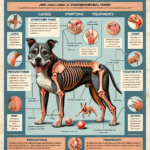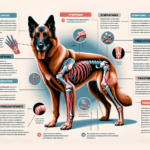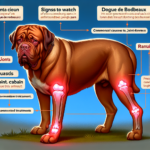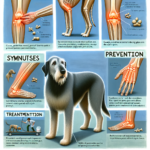Staffordshire Bull Terrier Joint Pain: Causes, Symptoms, Prevention, and Treatment

Introduction
The Staffordshire Bull Terrier, often affectionately referred to as the “Staffy,” is a breed known for its muscular build, intelligence, and affectionate nature. Originating from England in the 19th century, the breed was initially developed for bull-baiting and later became a popular companion dog. Staffies are characterized by their strong, stocky bodies, broad heads, and expressive eyes. They are known for their loyalty, courage, and friendly disposition, making them excellent family pets.
Like many breeds, Staffordshire Bull Terriers are prone to certain health issues. Among these, joint pain is a significant concern that can affect their quality of life. Joint pain in dogs can stem from various causes, including genetic predispositions, age-related wear and tear, and lifestyle factors. For a breed as active and robust as the Staffordshire Bull Terrier, maintaining joint health is crucial to ensure they lead a happy and active life.
Breed-Specific Joint Pain Risks
Genetic Predisposition
Staffordshire Bull Terriers have a genetic predisposition to several joint-related issues. Hip dysplasia, a condition where the hip joint doesn’t fit properly into the hip socket, is relatively common in this breed. This misalignment can lead to arthritis and significant pain over time. Elbow dysplasia, another hereditary condition, affects the elbow joint and can cause lameness and discomfort. Additionally, osteoarthritis, a degenerative joint disease, can develop as a secondary condition to these genetic issues.
Age-Related Risks
As Staffordshire Bull Terriers age, the risk of joint pain increases. The breed typically shows signs of aging around 7 to 9 years old, although this can vary. Older dogs are more susceptible to arthritis and other degenerative joint conditions due to the natural wear and tear on their joints over time. It’s essential for owners to monitor their dogs for any signs of discomfort as they age and to take proactive measures to support joint health.
Activity Level and Joint Stress
Staffies are known for their high energy levels and love for physical activities. Whether it’s running, playing fetch, or participating in agility training, these activities can put significant stress on their joints. While exercise is vital for their overall health, excessive or high-impact activities can exacerbate joint issues. It’s crucial to strike a balance between keeping them active and not overburdening their joints.
Common Symptoms of Joint Pain in Staffordshire Bull Terriers
General Symptoms
Owners should be vigilant for common symptoms of joint pain in their Staffordshire Bull Terriers. These symptoms include:
- Limping: A noticeable limp or favoring one leg over another.
- Stiffness: Difficulty in getting up or lying down, especially after rest.
- Reluctance to Move: Hesitation or refusal to engage in physical activities they once enjoyed.
- Swelling: Visible swelling around the joints.
- Behavioral Changes: Increased irritability or signs of discomfort when touched.
Breed-Specific Symptoms
In Staffordshire Bull Terriers, joint pain may manifest in specific ways due to their muscular build and activity levels. Owners might notice a decrease in their dog’s enthusiasm for play or exercise, or a change in their gait. Additionally, the breed’s stoic nature means they might not show obvious signs of pain until the condition is more advanced, making regular monitoring essential.
When to Consult a Vet
If any of the above symptoms are observed, it’s crucial to consult a veterinarian promptly. Early diagnosis and intervention can significantly improve the prognosis and quality of life for a dog suffering from joint pain. Regular veterinary check-ups are also essential for early detection and management of joint issues.
Preventive Measures for Joint Health
Exercise Recommendations
Maintaining an appropriate exercise routine is vital for the joint health of Staffordshire Bull Terriers. Low-impact activities such as swimming and controlled leash walks are excellent options. These exercises help maintain muscle mass and joint flexibility without putting excessive stress on the joints. Avoid high-impact activities like jumping or running on hard surfaces, which can exacerbate joint issues.
Dietary Suggestions
A balanced diet rich in essential nutrients can support joint health. Foods containing glucosamine and chondroitin can help maintain cartilage health. Omega-3 fatty acids, found in fish oil, have anti-inflammatory properties that can alleviate joint pain. Consult with a veterinarian to determine the best diet and supplements for your Staffordshire Bull Terrier.
Weight Management
Maintaining a healthy weight is crucial for reducing joint stress. Excess weight puts additional pressure on the joints, exacerbating pain and discomfort. Regular exercise and a balanced diet are key to keeping your Staffordshire Bull Terrier at an optimal weight. Consult your vet for specific weight management guidelines tailored to your dog’s needs.
Early Screening and Monitoring
Early screening for joint issues can help catch problems before they become severe. Regular veterinary check-ups should include joint assessments, especially as your dog ages. X-rays and other diagnostic tools can help identify early signs of joint problems, allowing for timely intervention.
Treatment Options for Joint Pain
Non-Surgical Treatments
Several non-surgical treatments can help manage joint pain in Staffordshire Bull Terriers:
- Medications: Anti-inflammatory drugs and pain relievers can provide relief from joint pain.
- Physical Therapy: Specialized exercises and therapies can improve joint function and reduce pain.
- Lifestyle Adjustments: Modifying activities and providing a comfortable living environment can alleviate stress on the joints.
Surgical Options
In severe cases, surgical intervention may be necessary. Common surgical options include:
- Hip Replacement: Replacing the damaged hip joint with an artificial one.
- Arthroscopy: A minimally invasive procedure to remove damaged tissue or repair joints.
- Joint Fusion: Fusing the joint to reduce pain and improve stability.
Consult with a veterinary orthopedic specialist to determine the best surgical option for your dog.
Alternative Therapies
Alternative therapies can complement traditional treatments and provide additional relief:
- Acupuncture: Can help reduce pain and improve joint function.
- Hydrotherapy: Water-based exercises that reduce joint stress while improving mobility.
- Massage: Can alleviate muscle tension and improve circulation around the joints.
Lifestyle and Management Tips
Daily Care Routine
A consistent daily care routine can help manage joint pain in Staffordshire Bull Terriers. This routine might include:
- Gentle morning walks to loosen stiff joints.
- Administering prescribed medications or supplements.
- Engaging in low-impact activities like swimming or controlled play.
- Providing a comfortable resting area with orthopedic bedding.
Modifying the Home Environment
Making your home more joint-friendly can significantly improve your dog’s comfort:
- Install ramps to help your dog navigate stairs or get onto furniture.
- Provide orthopedic beds to support their joints while resting.
- Ensure food and water bowls are at a comfortable height to reduce strain.
Long-Term Management
Long-term management strategies are essential for keeping your Staffordshire Bull Terrier active and happy despite joint pain:
- Regular veterinary check-ups to monitor joint health.
- Consistent weight management to reduce joint stress.
- Ongoing physical therapy or alternative treatments as needed.
- Adjusting activities to match your dog’s comfort level and capabilities.
FAQs About Staffordshire Bull Terriers and Joint Pain
What are the early signs of joint pain in Staffordshire Bull Terriers?
Early signs include limping, stiffness, reluctance to move, and behavioral changes such as irritability or discomfort when touched.
Can joint pain in Staffordshire Bull Terriers be prevented?
While genetic predispositions can’t be entirely prevented, maintaining a healthy weight, providing a balanced diet, and engaging in appropriate exercise can significantly reduce the risk of joint pain.
Are there specific supplements that can help with joint health?
Yes, supplements containing glucosamine, chondroitin, and omega-3 fatty acids can support joint health and alleviate pain.
When should I consult a vet about my dog’s joint pain?
If you notice any signs of joint pain, such as limping, stiffness, or reluctance to move, consult your veterinarian promptly for a thorough evaluation and appropriate treatment plan.
Conclusion
Joint pain is a significant concern for Staffordshire Bull Terriers, but with proper care and attention, it can be managed effectively. By understanding the breed-specific risks, recognizing early symptoms, and taking preventive measures, owners can help ensure their dogs lead active and comfortable lives. Regular veterinary check-ups, a balanced diet, appropriate exercise, and a supportive home environment are key to maintaining joint health. Always consult with your veterinarian for personalized advice and treatment options to keep your Staffordshire Bull Terrier happy and healthy.




